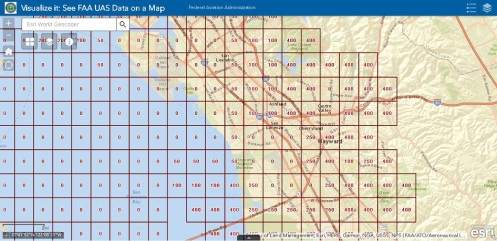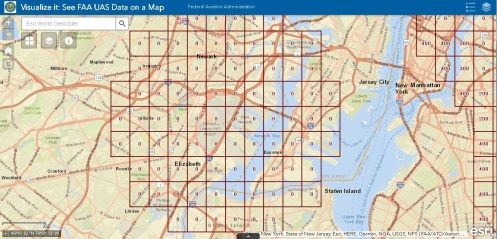Part 107 Waivers and Authorizations — a Primer
In addition to my forays into GPU compute, distributed computing, AI, and VR (my day job) I’m also a licensed drone pilot (USA). I get a lot of questions about this from colleagues in the drone services industry since I’ve successfully obtained FAA waivers in the past, so I put together a primer for Part 107 Pilots who are frustrated with the current FAA Waiver system, with a potential solution. We’ll talk about municipal and film permits in a later post…
Most of us Part 107 pilots have experienced this scenario: A very lucrative photography, mapping, or inspection job drops in your company’s lap to bid on. You have the equipment and fleet, hours of flying time doing the same type of work, and know the area intimately. You have references and reel/data to prove it… but the job entails flying just inside the veil of a Class Bravo SFC-10000 AGL pancake. Worse yet, it’s in a municipality that requires film permits…. and the only good launch and land site is a City Park.
You kindly provide your prospective suitor your bid, but that it will probably be at least 60 days to get the Waiver and City Special Parks Use Permit squared (you say to yourself, “that’s awfully optimistic, but hey, if they look it up on the FAA site for confirmation, that’s what the FAA says…”). Then the client goes dark: emails stop, they stop returning phone calls, and a couple weeks later you learn they just hired a kid from down the block with a Phantom 3 he bought at Best Buy to fly the job, with no heed to regulations or safety (let alone legality).
Now this is certainly frustrating, but there is a bit of prophylaxis you can apply to prevent this in the future, and there is a bonus — which I will discuss later. The first is to understand the difference between an Airspace Authorization and an Airspace Waiver.
107.41 Airspace Authorizations
An Airspace Authorization is a short-term — under 6 months — pass to fly in a small area of Class Bravo through Echo airspace, usually with severe restrictions as to altitude and radius of operations. These are the ones that are actually starting to go through quickly (if you can call 60 days “quickly”). To get on this speed-of-smell fast-track, one should look at the UAS Facility Maps available at:
https://faa.maps.arcgis.com/apps/webappviewer/index.html?id=9c2e4406710048e19806ebf6a06754ad
An example such UAS Facility Map is below, for the East side of the San Francisco bay area:

The numbers in the grid squares are guidelines: they are not hard-and-fast limits. But if you want a 60-day application turn-around, if you stay within the altitude limits in your grid squares within the radius of your Authorization application, the process is mostly automated (but still presently takes 60 days, but they hope to largely automate it to under 2 weeks eventually, as long as you stay within the limits). *[Notice we’re mixing grid squares and the radius of a circle. If you think about it a while, you can see how perversely devious this is for the FAA to do, in a bureaucratic kind of way]. You can, in the example above, request an Authorization for over 50 feet AGL along the north side of the Hayward Regional Shoreline (the grid marks 50 AGL as maximum altitude), but then your application goes into the manual examination pile — and this is where it gets interesting.
One you stray outside of the grid limits, you’re in no man’s land. Let’s say we request 100 AGL in a very tight location at Hayward Shoreline. Some physical person from the FAA will have to get to your application in the pile (weeks), and they will literally call the FSDO (local Flight Standards District Office) for their opinion, which is usually neutral — they usually say to call the Airport Manager for their opinion. So then a few weeks later the FAA calls the Airport Manager for Oakland Intl. Airport (KOAK) who then directs them to the airport’s UAS subject matter expert, who is probably on vacation. Weeks. Finally, the FAA counterpart gets the SME for KOAK on the phone or email, but what happens next is really a matter of culture. Some SME’s are militant anti-drone, and others are much more friendly (“Sure, no problem, but if they’re going to do a flight over 50 AGL, have them contact the tower via phone a day before”). Meanwhile 6 months have passed, and we haven’t even touched on the fact that Hayward Shoreline is a California State Park…
For an example of a hostile SME for an airport, just take a look at KEWR’s (Newark Liberty) UAS facility map:

Basically what they’re telling you through numbers is that there is No Way you are getting a 107.41 Authorization within a 100 kiloton-blast radius of KEWR.
Clearly the Authorization process is pretty broken at the present time for anyone responding to bids for jobs in airspace classified other than Golf. But who flies these jobs then? 1) Folks with Section 333 Exemptions, but these are being phased out and 2) Folks with 107.41 Waivers, not Authorizations.
107.41 Airspace Waivers
Now the gentle reader may think to themselves “but I’ve read FAR stem-to-stern, and especially 107.41, in which nowhere does it say anything about a “waiver” only “ATC authorization”. It’s not a legal, nor regulatory distinction, but rather an administrative one. Under six months, tight radius, and within the UAS Facility Map grid limits? It’s an Authorization. There is no pre-flight contact to ATC required. Two years term with a 2 nautical mile radius at full-on 400 AGL near a major airport like LaGuardia? That’s a Waiver. Long-term waivers are great, but they generally come with many more restrictions than mere Authorizations such as:
- One or more Visual Observers required;
- Contacting the tower 30 minutes prior to operation (and they can veto);
- Contacting the tower immediately after finishing;
- Having two-way radio comms capability for emergencies;
- Forget conjoining your 107.29 nighttime waiver with your airspace waiver, unless you’re really cheeky; and
- You’ll have gray hair by the time they approve it (if they do approve it, and if you don’t have gray hair already).
However, the advantages of having overlapping long term waivers in your business territory are obvious:
- You can respond immediately to RFPs;
- You have a marketable piece of paper, sort of like just having your Part 107 license to begin with;
- You can advertise this fact to all prospective clients; and
- The National Air Space will be safer.
However, this does require foresight on the part of the operator. What areas am I going to likely be operating in? What ones have I been asked to operate in, in the past, that I couldn’t because of airspace classification?
Conclusion
That being said, I personally believe that having a long term Waiver, not Authorization, is the way to go. While it may take 6 months to get, if you’re in this for the long-haul I would suggest looking ahead and applying for long term Waivers in your business territories instead of reacting to client bids and applying for short term Authorizations (and then losing the jobs as you wait — to weekenders endangering the National Air Space). Down the road I’ll write about the next layer of the onion — municipal film permits and park special use permits.
